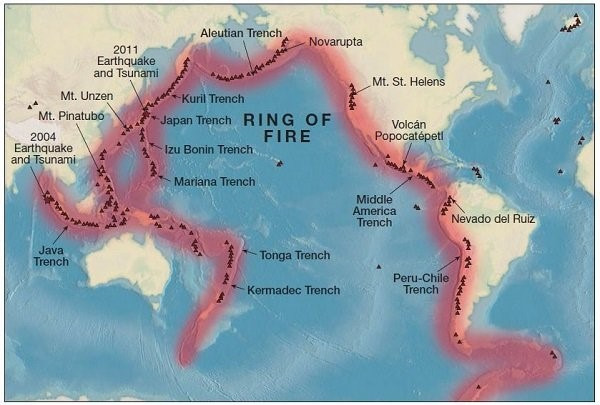Context:
A recent study has uncovered a surprising connection between the Tonga volcano eruption in the South Pacific Ocean and the formation of Equatorial Plasma Bubbles (EPBs) over the Indian subcontinent. This discovery highlights the far-reaching impact of volcanic activity on atmospheric phenomena.
Relevance:
GS I: Geography
Dimensions of the Article:
- Key Highlights of the Tonga Eruption Study
- Understanding Equatorial Plasma Bubbles (EPBs)
- Key Facts About the Tonga Volcano
- About the Ring of Fire
Key Highlights of the Tonga Eruption Study
Ionospheric Disturbances
- The Tonga eruption significantly influenced space weather, impacting satellite signals through ionospheric disturbances.
- The eruption generated strong atmospheric gravity waves that ascended into the upper atmosphere, creating favorable conditions for the formation of Equatorial Plasma Bubbles (EPBs).
Atmospheric Dynamics
- Gravity Waves: These waves occur when buoyancy forces air upward and gravity pulls it back down, leading to oscillations that propagated extensively due to the eruption.
- Detection of Plasma Blobs: Increases in the ionospheric eastward electric field at dusk were observed, indicating further disruptions in the ionosphere.
Understanding Equatorial Plasma Bubbles (EPBs)
Nature and Formation
- EPBs are formed through plasma instabilities in the equatorial ionosphere, manifesting as regions of depleted plasma.
- While they originate in the equatorial ionosphere, EPBs can extend and affect the global ionosphere up to 15° north and south of the Earth’s equator.
Impacts on Communication
- EPBs can scatter radio waves traveling through the ionosphere, leading to significant signal degradation.
- This scattering is a critical issue for systems dependent on high-frequency radio waves, including satellite communications and GPS.
Variability
- EPBs are most frequently observed during the Winter solstice and are least common during the Summer solstice, indicating significant seasonal variability.
Key Facts About the Tonga Volcano
- Situated in the western South Pacific Ocean, west of Tonga’s main inhabited islands.
- Part of the Tofua Arc, which itself is a segment of the larger Tonga-Kermadec volcanic arc, known for its active subduction zone dynamics.
- The volcano is part of the Ring of Fire, formed by the subduction of the Pacific Plate beneath the Indo-Australian Plate.
Volcanic Features
- Submarine Volcano: Comprising two small uninhabited islands, Hunga-Ha’apai and Hunga-Tonga, it highlights the undersea nature of volcanic activity in this region.
About the Ring of Fire
- Many volcanoes in the Ring of Fire were created through a process of subduction. And most of the planet’s subduction zones happen to be located in the Ring of Fire
- It is a string of at least 450 active and dormant volcanoes that form a semi-circle, or horse shoe, around the Philippine Sea plate, the Pacific Plate, Juan de Fuca and Cocos plates, and the Nazca Plate.
- There is a lot of seismic activity in the area.
- 90 per cent of all earthquakes strike within the Ring of Fire

-Source: Indian Express



